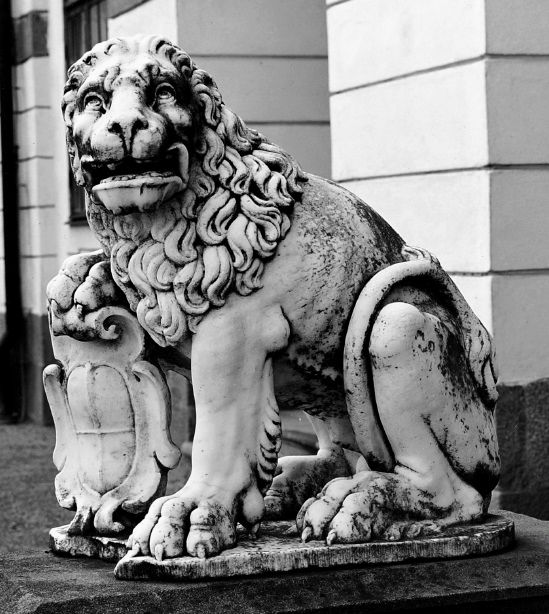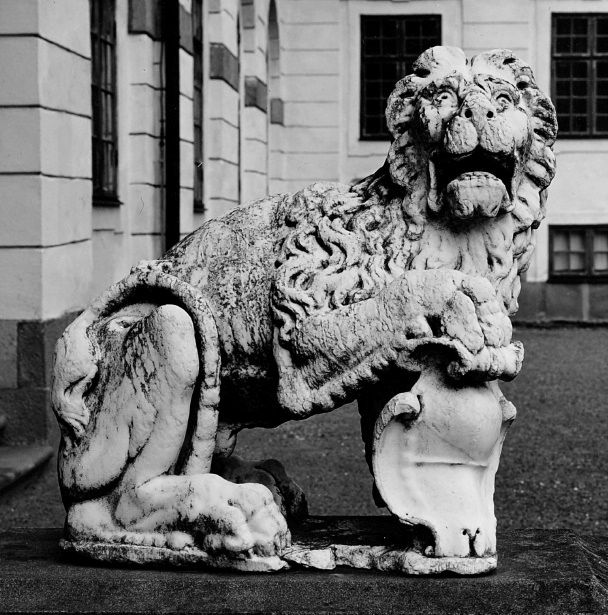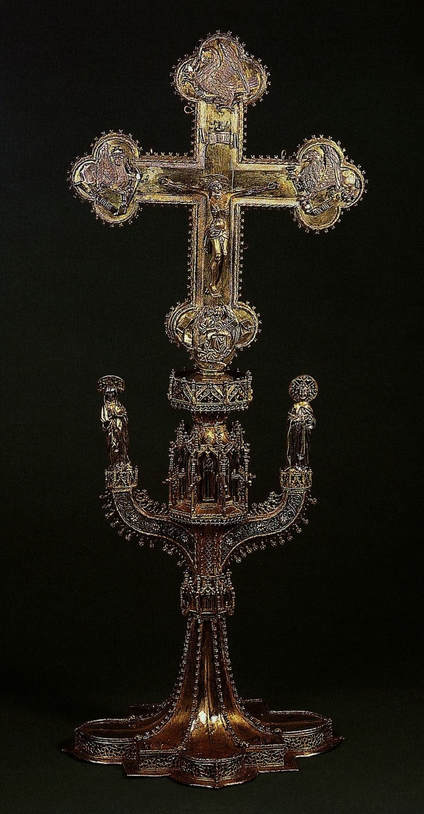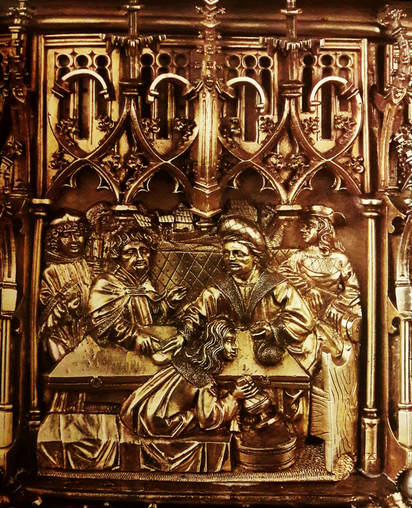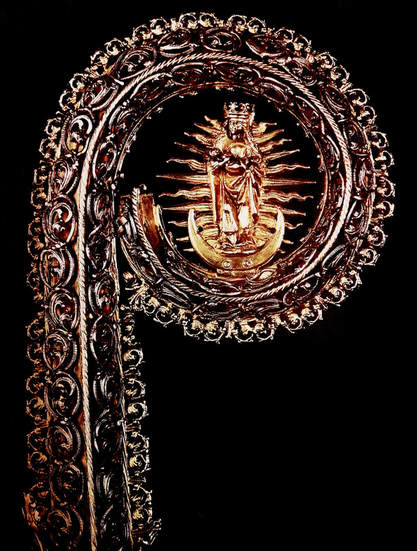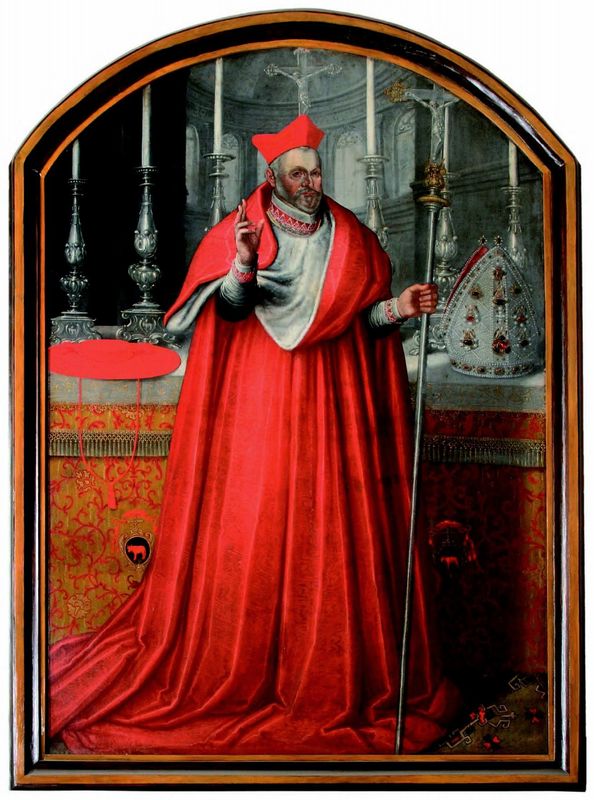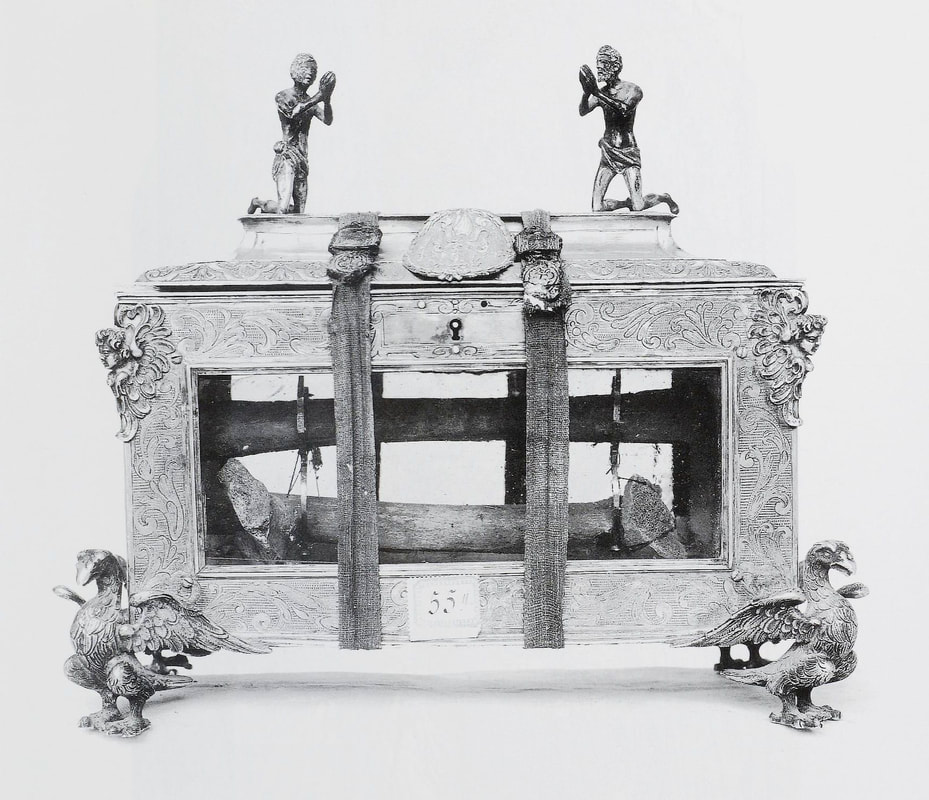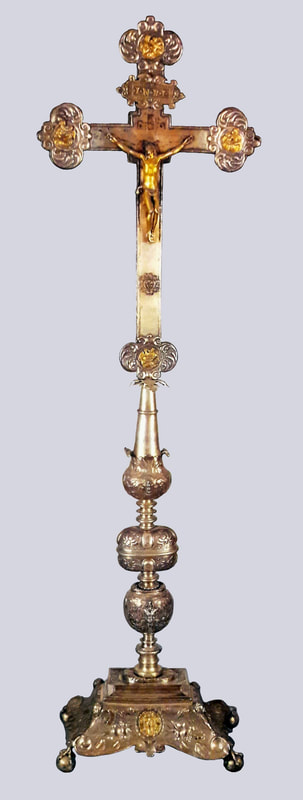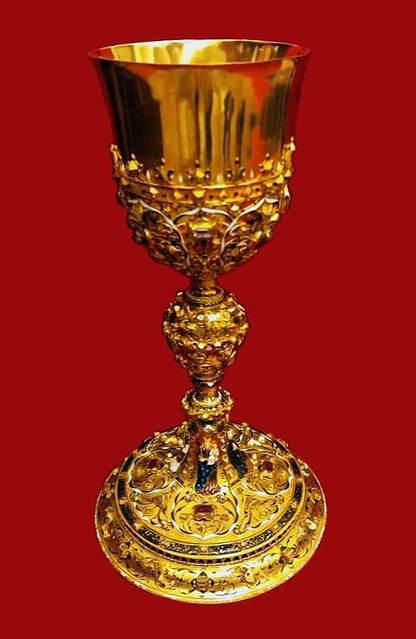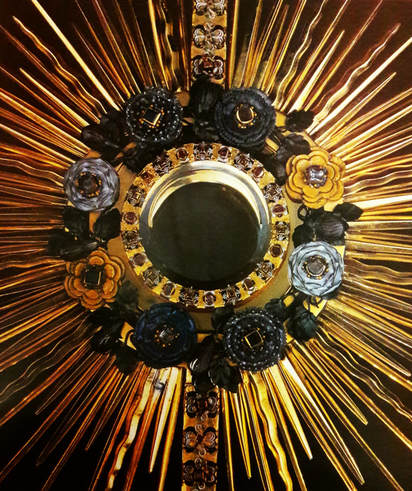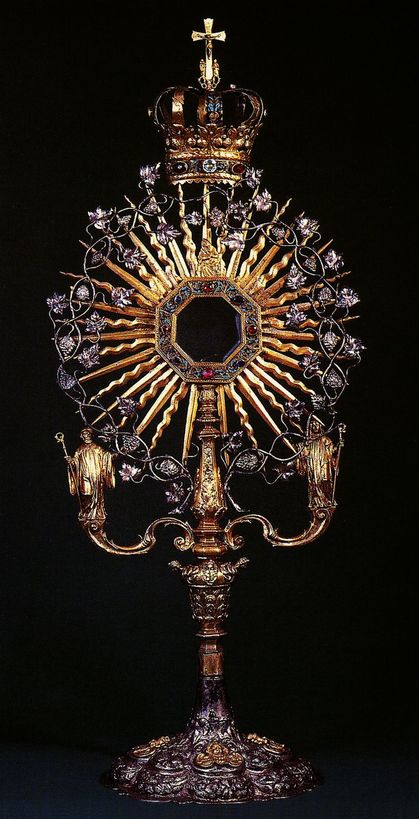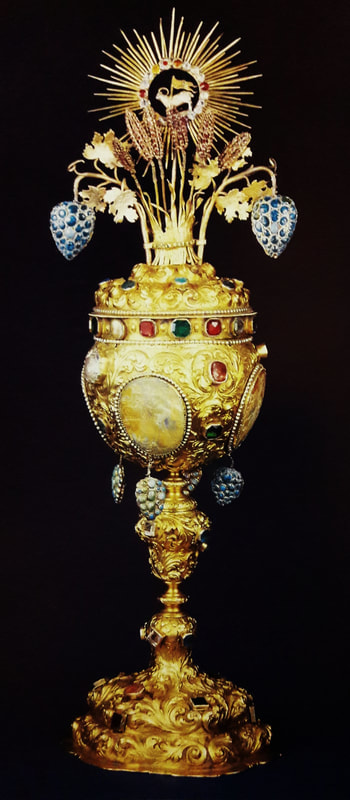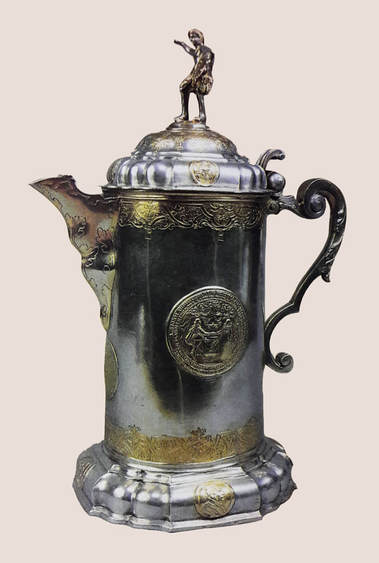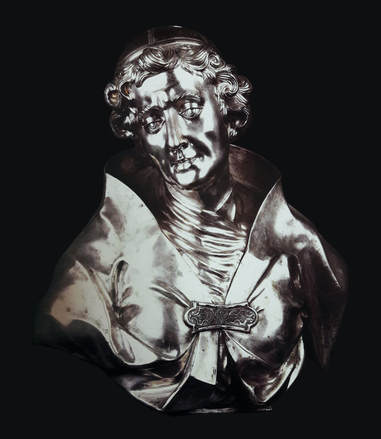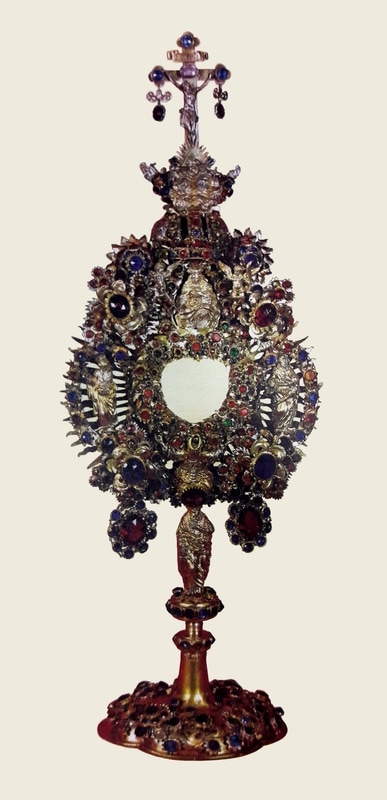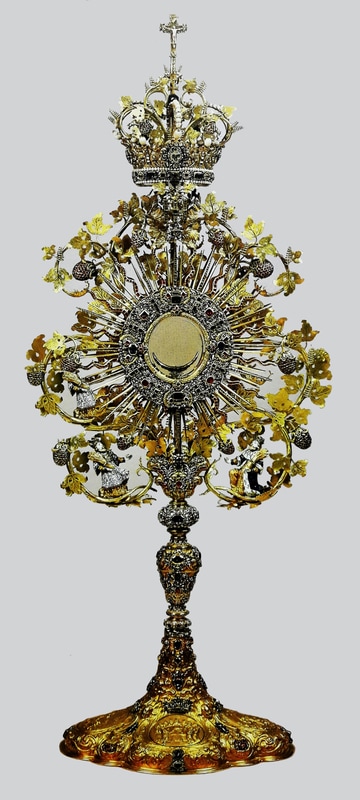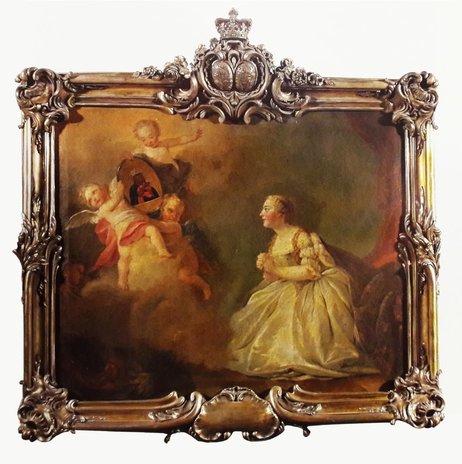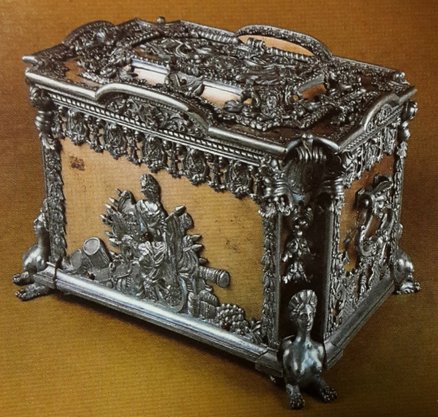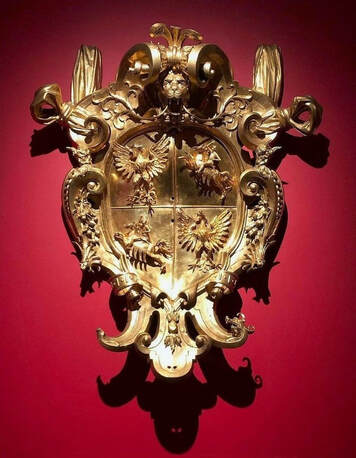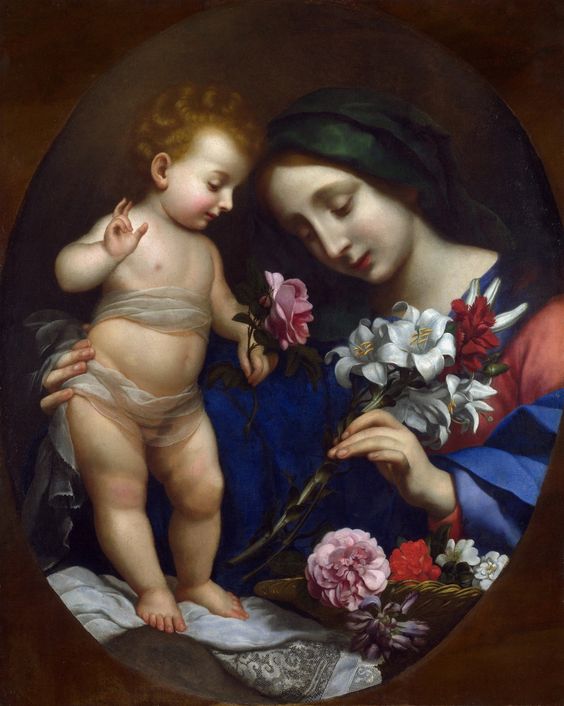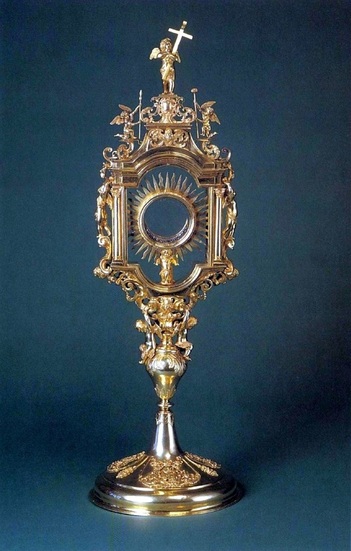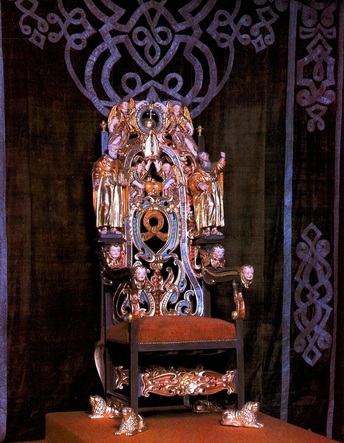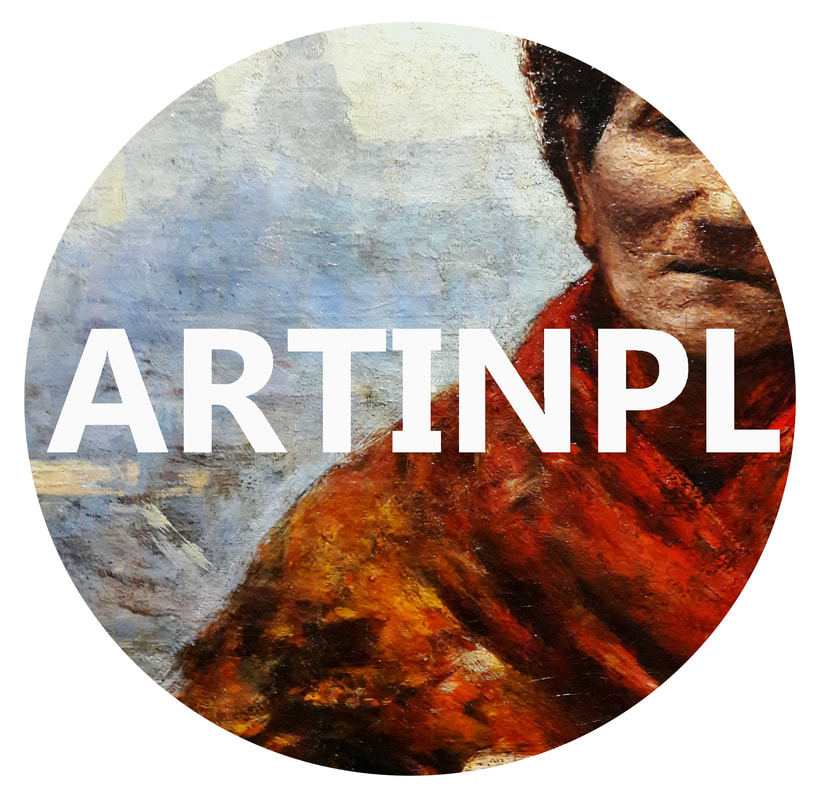|
Two marble lions at the main gate of the Drottningholm Palace in Sweden, credited by some sources as possibly taken by the Swedish forces from the Frederiksborg Castle in Denmark, could be rather, beyond any doubt, identifed with four marble lions described by Adam Jarzębski in his "Short Description of Warsaw" from 1643, as adorning the entrance to the Ujazdów Castle in Warsaw - I lwy cztery generalne, Między nimi, naturalne, Właśnie żywe wyrobione, A z marmuru są zrobione; Nie odlewane to rzeczy, Mistrzowską robotą grzeczy (2273-2278).
In the 1630s, before his wedding with Cecilia Renata of Austria, Ladislaus IV Vasa made several commissions for sculptures in Florence, including possibly lions for his palace in Ujazdów. Both material, Italian marble, and a form similar to Medici lions, makes this assumption more probable. Also quarterly divided fields of lions' escutcheons with wiped away crests, suggest an eagle and a knight of Poland-Lithuania, rather than more complex emblems of Christian IV of Denmark.
Marble lion from the Ujazdów Castle by Anonymous from Italy, 1630s, Drottningholm Palace. Photo: Nationalmuseum (CC BY-SA).
Marble lion from the Ujazdów Castle by Anonymous from Italy, 1630s, Drottningholm Palace. Photo: Nationalmuseum (CC BY-SA).
Main religious centers of Poland were also main centers for religious craftemanship in the country. Kraków with its status of coronation city and largest city of southern Poland had an adantage over other locations with the largest number of goldsmiths. A diploma issued in 1478 by Jan Rzeszowski, Bishop of Kraków, Jakub Dembiński, castellan and starost of Kraków, Zejfreth, mayor of Kraków, Karniowski and Jan Theschnar, Kraków's concillors to Jan Gloger, son of Mikołaj Gloger, aurifaber (goldsmith) of Kraków, recognizes Jan as a man of good fame and worthy of admission to the guild of goldsmiths. The document confirms that church had a profound influence on development of this craftsmanship in the country.
Reliquary cross of Andrzej Nosek of Rawicz coat of arms, Abbot of the Tyniec Abbey by Anonymous from Kraków, ca. 1480, Cathedral Treasury in Tarnów.
Fragment of gold reliquary for the head of Saint Stanislaus with selling of a village by Marcin Marciniec, 1504, Cathedral Museum at Wawel Hill in Kraków.
Silver crosier of Bishop Andrzej Krzycki by Anonymous from Kraków, 1527-1535, Płock Cathedral.
Portrait of Primate Bernard Maciejowski (1548-1608) by Anonymous from Kraków, ca. 1606, Franciscan Monastery in Kraków. The Primate was depicted holding silver legate's cross against silver altar set commissioned by him before 1601 in Italy and with a 15th century jewelled mitre of cardinal Frederick Jagiellon.
Reliquary of Saint Stanislaus founded by Bishop Marcin Szyszkowski by Anonymous from Poland, ca. 1616-1621, Basilica of Saint Francis of Assisi.
Silver altar cross offered by Primate Wacław Leszczyński to the Gniezno Cathedral by Anonymous from Poland, first quarter of the 17th century, Archdiocesan Museum in Gniezno.
Gold chalice founded by Anna Alojza Chodkiewicz by Anonymous from Poland, ca. 1633, Treasury of the Lublin Archcathedral.
Fragment of a monstrance adorned with jewels from private donations by Anonymous from Lublin, ca. 1650, Dominican Monastery in Lublin.
Fragment of monstrance adorned with enamel by Anonymous from Poland, 1670s, Treasury of the Jasna Góra Monastery.
Monstrance with St. Benedict and St. Scholastica from the Tyniec Abbey by Anonymous from Lesser Poland, 1679, Cathedral Treasury in Tarnów.
Ciborium adorned with mother of pearl founded by guardian Stefan Opatkowski by Anonymous from Kraków, 1700, Franciscan Monastery in Kraków.
After two centries of domination as the main center of craftmanship of the Polish-Lithuanian Commonwath, the country's main port, Gdańsk, began to decline in the beginning of the 18th century. The transfer of royal court from Dresden, into Warsaw during the Seven Years' War in 1756, ended another half-century hegemony of the Saxon capital. Royal court in the capital of the Kingdom of Poland favored greatly developmnent of local workshops. Also many skilled gold- and silversmiths from other locations began to settle in Warsaw. Among the most notable were Antoni Ignacy Mietelski (d. 1737), originally from Warka, who settled in Warsaw in 1717. In 1725, 1733 and 1737 he was the senior of the city's guild of goldsmiths. Mietelski is the author of two silver jugs in similar proportions, one set with coins from around 1720 (Czartoryski Museum) and the other from 1726 made for the city council and adorned with the symbol of Warsaw - a siren (National Museum in Warsaw). The Warsaw's jug signed with monogram AM was commissioned by the mayor of Warsaw, Józef Benedykt Loupia.
The privilage of king Stanislaus Augustus Poniatowski from 1785 and subsequent orders sanctioned Jewish workshops not affiliated with a guild and impose strict rules on marking the objects (grade of silver, mark of the manufacturer and other hallmarks). Among the most notable goldsmiths of that time were Szymon Stanecki, treasurer of the guild from 1785, active till 1810, who signed his works with monogram SS. He is the author of a silver tureen with handles in the form of a ram's heads and a cover topped with an artichoke dated to about 1785 to 1788 (National Museum in Warsaw). Hil Jakubowicz, a Jewish goldsmith from Łask, who was appionted as one of the five state melters in 1788, is an author of an octagonal filgree basket from about 1785 to 1787. Teodor Pawłowicz, mentioned in the Royal priviledge from 1785 as a deputy senior of the guild and active till at least 1789, and Józef Skalski marking his works with monogram IS, active in the end of the 18th century. Foreigneres are represented by Karl Ludwig from Dresden, mentioned in the books of the Węgrów-Warsaw evangelical parish in 1785 and author of two silver tureens signed with monogram CL. Martin Holck, mentioned in the books of the mentioned parish in 1783 and active till 1794, Josef Götz called Gallus from Moravia, active in Warsaw from about 1773 till the end of the century and J.M. Schwartz who signed his works with monogram I.M.S. Unidentified by name silversmiths are Monogrammist IGB, possibly from Poznań, active from the 1770s till the end of the century, author of two tureens from the service of Michał Kemblan Chelkowski, chamberlain of king Stanislaus Augustus that can be dated to about 1785 to 1788.,Monogrammist ASW, Monogrammist GSS and Monogrammist AK, all active in Warsaw in the 1780s.
Silver jug with marriage medal of king Ladislaus IV Vasa and Cecilia Renata of Austria by Antoni Ignacy Mietelski, ca. 1720, Czartoryski Museum.
Silver bust of Saint Stanislaus from Gniezno Cathedral by Anonymous from Warsaw, 1726, Museum of the Gniezno Archdiocese.
The richly decorated 17th-century monstrance of Bishop Stanisław Kazimierz Dąmbski's foundation, is used exclusively for displaying the Blessed Sacrament on Good Friday and during the solemn procession of the Resurrection on Holy Saturday. It was created between 1680 and 1699 possibly by a Silesian goldsmith Christian Schrötter in Kamienna Góra. Made in silver and adorned with semi-precious stones, it represents Christ in the form of a Host, accompanied by figures from the Old (Abraham, Melchizedek) and New Testament (Mother of God, St. Joseph, St. Peter). It was bequeathed to the Wawel Cathedral by the founder as an equivalent for the gold chalice and silver sanctuary lamp offered traditionally by the bishops at their inauguration.
Bishop Stanisław Dąmbski's monstrance by Christian Schrötter in Kamienna Góra, 1680-1699, Cathedral Museum at Wawel Hill in Kraków.
The monstrance, a chief example of the 17th century Polish goldsmithery, was commissioned by Augustyn Kordecki, Abbot of the Jasna Góra Monastery and later Provincial of the Pauline Fathers, as an ex-voto for the defence of the monastery during the invasion of the Polish-Lithuanian Commonwealth by the neighbouring nations in 1655, so-called Deluge. It was created in 1672 in Warsaw by Royal goldsmith Wacław Grotko from Prague in Czechia (also known as Grottke or Grottkau, active in Warsaw between 1665 and 1675), who was paid 30,000 zlotys in gold.
The work was made from jewels donated by pilgrims to the monastery. Over one meter high (103 cm) and over 13 kg weight monstrance was adorned with 2.366 diamonds, 2.208 rubies, 30 saphires, 81 emeralds, 215 pearls and enamel. A large diamond set in the crown at the top, was bequeathed to the monastery by Zygmunt Przerembski, voivode of Sieradz in 1668. Prophet Aaron and King David kneeling at both sides of the glory are holding wheat sheaves, an eucharistic symbol. Scenes at the foot of the monstrance are related to two themes: the sacrifice of Christ (the Sacrifice of Abraham and the Passover) and the eucharist (Elijah in the Desert and the Last Supper). According to inscription on the base of the monstrance, Father Augustyn Kordecki was Provincial, Father Stanisław Ligęza was Abbot of the Jasna Góra Monastery and Father Romuald Dymalski was Sacristan of the monastery at the time of its creation.
Abbot Augustyn Kordecki's monstrance by Wacław Grotko in Warsaw, 1672, Treasury of the Jasna Góra Monastery.
Maria Josepha of Saxony visited the Jasna Góra Monastery with her sister Maria Anna Sophia on May 23rd, 1744. Daughters of Augustus III of Poland and Saxony offered to the Black Madonna of Częstochowa two gold hearts with their names as votive offering. In 1747 the princess married Louis, Dauphin of France (1729-1765) and some time later, in 1756, through intermediary of Duchess Jabłonowska, she sent to Jasna Góra a votive offering for healing her husband. The oil on canvas painting by anonymous French painter is set in a rich bronze frame, cast, chased and gilded, adorned with rocaille motifs and cartouches with coat of arms of Maria Josepha (Polish-Lituanian Commonweath and Kingdom of France). Inscription on frame informs about the intentions of the Dauphine of France. Both the painting and frame were creted by French workshop. Similar example of craftmanship is a late baroque strongbox with monogram of Augustus II of Poland by Pierre Fromery.
Votive painting of Maria Josepha of Saxony by Anonymous from France, ca. 1753, Treasury of the Jasna Góra Monastery.
Strongbox with monogram of Augustus II the Strong by Pierre Fromery, 1697-1733, Czartoryski Museum.
The second reception stairway, the Senators' Staircase, of the Wawel Castle was constructed between 1599 and 1602 by Giovanni Trevano and Ambrogio Meazzi in the north-west corner of the castle. It is the first such modern construction in Poland facilitating the communication between the floors of the residence and located in the interior space of the edifice. Marble stairs do not run steeply, as it is in the Renaissance Deputies' Staircase, but break up regularly in the middle floors with comfortable podests. Early baroque portals of the saircase with auricular elements designed by Trevano were executed in greenish Carpathian sandstone by Meazzi. The Summary of the Royal spendings by the Kraków's supevisor Franciszek Rylski of Ostoja coat of arms from 1599 and 1600 in the Central Archives of Historical Records in Warsaw (I 299), records a spending of fl. 2991 gr. 15 den. 12 "for demolition of the old stairs and construction of the new one, for Italians and different materials" and salaries of "Jan Treurer (Giovanni Trevano), mason ad r[ation]em fl. 1300 datum fl. 1250" and "Ambrosio Meaczi (Ambrogio Meazzi) to inlay the stairs and doors ad r[ation]em fl. 500 datum fl. 300".
Senators' Staircase of the Wawel Castle, constructed between 1599 and 1602 by Giovanni Trevano and Ambrogio Meazzi.
Bronze cartouche with coat of arms of the Polish-Lithuanian Commonwealth without the Vasa emblem (missing) from the Wawel Castle by Anonymous from Poland, 1604, Czartoryski Museum. One of the cartouches from the overdoor in the northern wing of the castle leading to the Senators' Staircase.
See more pictures of Wawel Royal Castle during the Vasas on Pinterest - Artinpl and Artinplhub
After his abdication as a King of Poland in 1669, John Casimir Vasa left for France to settle in Paris in Abbey of Saint-Germain-des-Prés as its abbot. He took with him a large portion of the preserved Vasa collections, which was later sold in Paris on an auction in 1673 after his death. Inventory of the sell lists over thousand items:
(Extract) 55. A Christ carved in Saint Lucia wood, in an ebony box (Mr. Robert, griffier, 37.10 pounds). 56. Three Polish style chests with two wooden and another covered with black leather, as it is (Mr. Corade the Younger, 7 pounds). 57. A small bending seat covered with red velvet and a green velvet convenience chair, with a basin and two crystal chamber pots (Mr. Argilly, 9 pounds). 58. An altar frontal and two crédances in green velvet, trimmed with embroidery. 77. A large mirror of Venetian glass, trimmed at its edge, blackened and varnished, with its frame, gold and silver and silk (Madame Garnier, 131.10 pounds). 78. Dead Christ with Virgin made in wax, large as nature enshrined in a blackened wooden case with a large Venetian glass in front (Mr. Torque, 550 pounds). 79. A terracotta Virgin holding the infant Jesus, with two small crowns of enameled gold in a walnut box (Duke of Creguy, 20 pounds). 95. St. Peter painted on wood, original by Rubens, with its border of black wood (Mr. Corade, 40 pounds). 96. Virgin, infant Jesus and St. Elizabeth, painted on wood, with its black frame (Mr. Torque, 28 pounds). 97. St. Joseph holding the Child, with God the Father, the glory of little angels, original by Claude (?) Callot, in gold frame (Mr. Buy, 25 pounds). 98. Virgin in oval, holding a bouquet of lilies, a small Christ holding a rose, black frame with silver ornaments (Mr. de Buy, 104 pounds). 99. Head of the Virgin in oval with two hands, black frame with silver elements (Mr. Lenosquy, 25 pounds). 100. A rose with a bud and a golden sun, with a motto in golden frame (Mr. du Moulins, 55 sols). 101. Two small paintings of St. Ignatius and St. Francis Xavier, with ebony frames (Mr. Cavaro, 6 pounds). 102. Effigy of Our Lord in a velvet case (Mr. Meusnier, 4.10 pounds). 103. Virgin with St. Elizabeth and St. Joseph, copy after Nicolas Poussin, in a white frame (Mr. Morin, 33.10 pounds). 104. Christ's head with its golden frame (Mr. de Buy, 92 pounds). 105. Descent from the Cross of Our Lord, painted on wood, without frame (Mr. Vacherot, 9.10 pounds). 106. Christ's head with its golden border (Mr. Boislabbé, 6.5 pounds). 107. St. Ignatius in an interior, who heals possessed in black frame (Mr. de Recourt, 9.10 pounds). 108. St. Anne who teaches the Virgin to read, with little angels above, a crystal glass with gold frame (Mr. Mamice, 25 pounds). 109. St. Dorothy in a gilded oval. 175. Two maces, one in ivory and other one lined with ivory (Mr. Lévesque, 8 pounds). 176. A rhinoceros horn, adorned with gilded silver, with a small cup of same material with a foot trimmed with silver (Mr. Le Blond, merchant-silversmith, 86.10 pounds for the horn, Ms. Garnier, 24 pounds for the cup). 177. A large Turkey carpet, as is (Reverend Father Barré, 30 pounds). 178. A large resting chair, trimmed and covered with brocade. 217. A pair of gauntlets with two Turkish helmets. 218. A large clock that marks the hours at night, with an ebony pedestal, with silver index and gilded brass elements, three little cupids and a silver eagle (Mr. Dupin, 500 pounds). 219. A counterweight pendulum clock in a blackened wooden frame (Phillibert Paturel, 56 pounds). 220. A counterweight pendulum clock in with a small silver dial and a small decoration at the top (Mr. Macon, 56 pounds). 221. A clock striking the hours, half hours and quarter hours, in a walnut case topped with brass (Madame de Turin, 80 pounds). 222. A pendulum clock that marks the minutes, with a large pedestal box (Reverend Father Barre, 240 pounds). 223. A spring clock, striking the hours and minutes, with an ebony pedestal, a large cross of white brass at the top and a crystal skull at the foot of the crucifix (Mr. Barbier, merchant-silversmith, 304 pounds). 224. A watch clock striking the hours, half-hours, quarters and repeats, marking the minutes, with a silver dial and a frame of gilded copper, adorned with embossed silver plate and foliage (Mr. Dupin, 230 pounds). 225. A pendulum clock, as it is (Mr. Galus, 220 pounds). 226. A clock that marks hours, half hours, the fourth months and moons and moon signs, all movements of steel instead of string, with an ebony and blackened wood pedestal, adorned with several figures in gilded brass and an eagle on top of the dial, with the coat of arms of the late Queen of Poland (Marie Louise Gonzaga), enamel on copper (Mr. Dupin, 160 pounds). 227. An alarm clock striking hours, half hours and quarters, which marks the month’s quarters, the holidays, the year, pendulum decorated with several silver foliage, gilded brass pedestal and such wood with a fortune above (Mr. Le Riche, 311 pounds). 228. A brass clock striking hours, half hours and quarters, with alarm (80 pounds). 232. A clock striking hours, half hours and quarters, moon signs, days of the week, the twelve signs of the seven planets, parts inside with chains, on ebony pedestal, the case adorned with ornaments made in gilded brass with an eagle above (Madame Pachau, 205 pounds). 233. A counterweight pendulum clock in a case of blackened wood, with brass plaques around which are engraved in gilded panoplies, copper whitened dial (Mr. Hardevillers, 46 pounds). 234. A clock on an ebony pedestal, which marks the hours with two globes both sides of the dial, one silver the other gold brass, with two small compasses at the bottom and a large compass made in gilded copper above and sphere made of gilded brass behind. 357. A small painting with a lemon on a plate and a silver overturned vase, in ebony frame (Mr. Clorasse, 6.10 pounds). 358. St. Joseph with infant Jesus, trimmed frame (Mr. Corade, 6.5 pounds). 359. A miniature on vellum, with ebony frame, representing the Crucifixion of Our Lord, with several figures, original by Hreusebon (Mr. Dupin, 71 pounds). 360. A painting of a woman with small children, frame adorned with ebony, original by Mactence (Mr. Corade, 21 pounds). 361. A vertical painting with a garland of fruits and an oval in the middle, vaubours figures and landscapes and fruits of obreville, original by above-named Masters (Jan Brueghel?), in a gilded frame (Mr. Bodin, 415 pounds). 362. A painting with a perspective of the Church in Gdańsk, without frame (Mr. Corade, 40 pounds). 363. A painting with Our Lord on the cross between two thieves, copy after Rubens, painted on copper, in black frame. 389. A head of Christ painted on copper, in ebony frame (Abbot de la Tour, 11 pounds). 390. A perspective of a temple with festivities, painted on wood, in a frame of blackened wood with gilded slats (Mr. Quesnel, 40 pounds). 391. A monk's head, in a black frame (Mr. de Buy, 35 sols). 392. A half-figure of weeping Heraclitus (Mr. Mauriceau, 38.10 pounds). 393. The portrait of a monk holding a cross in his hands, painted on canvas (Mr. Corade, 110 sols). 394. A half- figure of laughing Democritus, original by Hendrik Goltzius (with 392). 395. The Conversion of Mary Magdalene with a cross, a skull, painted on canvas, without frame (Mr. Corade the Younger, 10.10 pounds). 396. Judith with the Head of Holofernes, painted on canvas, no frame. 439. A large vertical painting with St. Joachim and St. Anne who teaches the Virgin to read, with angels, painted on canvas (Mr. Duchemin, 41 pounds). 440. A picture painted on canvas, which shows a naked woman, without frame (Mr. Bruny, 16.10 pounds). 441. A Satyr who eats from a pot with a peasant, a story from Metamorphosis (Mr. De Buy, 35.10 pounds). 457. A painting of medium size, with the Virgin's Genealogy, copy after Raphael, black frame (Mr. Bonhomme, 36 pounds). 458. A painting which shows a Virgin in Glory, with adoring King at the bottom and Saint John, original, in black frame (Mr. Torque, 21 pounds). 459. A small canopy of crimson velvet, trimmed with gold and silk, tailless (Mr. Ollivier, upholsterer, 151.10 pounds). 480. Twelve broken (folded ?) ebony chairs, trimmed at their edges with upholstery of red velvet embroidered with gold and trimmed with fringe, gold and silk, accompanied with twelve cushions, also of red velvet embroidered with gold on one side only (Madame Garnier, 250 pounds). 481. Two large parade chairs covered with velvet crimson, which wooden feets, arms and other ornaments are made of Polish silver, sewn with pearls in other places. The said two armchairs are upholstered with velvet embroidered cushions with small gold glands (Madame Garnier, 1703 pounds). 630. A cane mottled with gold and silver with a screwing ivory handle and lower parts in silver (Mr. François, 56 sols). 631. A Cossack style baton made in a wood from India, with a lion’s head at the end and a silver hoop (Abbot de la Mothe, 6 pounds). 632. A baton of the late King of Poland made in a wood from Brazil, set with gold at both ends (Mr. Rondet, 27.10 pounds). 646. An ebony cabinet with two doors with drawers, with an inkwell and compact with two small lids and two rings of Polish silver (Mr. Dupin, 120 pounds). 647. Another cabinet, similar to above one, with silver settings (Mr. Dupin, 38 pounds). 648. An ebony checkerboard with black and white checkers, and a game of chess. 649. Eight high-warp tapestries representing the Life of Solomon, and four other high-warp tapestries representing Saul and Solomon, 54 French ell width altogether by 3.5 French ell high, the twelve pieces constitute two hangings (Mr. Maré, 1413 pounds for seven pieces, the said Mr. Maré, 1002 pounds for five pieces). 650. A walnut cabinet of on a twisted column, topped with several drawers and small plates of gilded copper serving as an ornament; a table and two similar wooden pedestals (Mr. Gallois, 120 pounds). 651. Fifteen pieces of tapestry of red velvet and gold brocade, 36 French ell width altogether by 2.3 French ell high, and twelve pieces of crimson red velvet, embroidered with gold and topped with a fringe of gold and silk, sloping from the said tapestry containing 36 French ell (Mr. Huvin, upholsterer, 2251 pounds). 655. A large gilded carriage for six, upholstered with Venetian velvet in palmettes on aurora background and blue flowers, with glasses and set on a chassis (sold by Mr. Torque). 656. A small carriage, upholstered with Venetian velvet in palmettes on aurora background and black flowers, with three glasses and set on a chassis (sold by Mr. Torque). 657. A large mourning carriage draped in black in and out, without glasses and set on a chassis (sold by Mr. Torque). 721. Four large plates, eight small, round basin, a jug with a cover, a saltcellar and dozen plates. Made of sounding pewter (Mr. Bourgeois, 43.02 pounds). 722. A large basin with figures in relief, accompanied with a vase, made of gilded German silver, on which is represented the horse Pegasus and the figure of Mercury, 62 marks and seven ounces of weight (Mr. Gerard, merchant-silversmith). 726. A ring with a purple ruby carved on eight sides with six faceted diamonds (Mr. De Buy, 1200 pounds). 727. Another ring with a long purple sapphire with six faceted diamonds (Mr. Macon, goldsmith, 600.10 pounds). 728. Ten pieces of Brussels’ tapestry representing the story of deeds of Ulysses (by Jacob Geubels), including parts sewn with gold, containing 56 French ell width by 3.5 French ell high (Mr. Dupin for Mr. Paul, agent of Charles I Louis, Elector Palatine, 12,000 pounds). 729. Four other pieces of Brussels’ tapestry representing the Deeds of Hercules and Triumph of Bacchus, sewn with gold containing 22 French ell width by 4 French ell high (Mrs. Bruneau, stored in the furniture repository of His Majesty close to the Louvre, 16001 pounds). Inventory made in Nevers 1. A tapestry of 40 strips of Venetian brocade, with slopes and fringe in various colors (Mr. de Buy, 400 pounds). 2. Thirteen ell of tapestry of 7 pieces, 2.5 French ell high, from Venetian brocade (not sold and left in Nevers). 3. A bed of wood with a red satin mattress; a bed and pillow filled with feather and covered with red taffeta, a pavilion with lining of brocade “Porte de Paris”; a green silk cover, with 3 bags of leather (Madame Filogue, 220 pounds). LL XII. Four portraits of four Princes of Neuburg (Mr. Corade, 12 pounds). CX LL. Amazon painted on canvas (Mr. de Buy, 110 sols). LL VI. A portrait of a Maltese Commander (Zygmunt Karol Radziwiłł?), painted on canvas (Mr. de Buy, 6 pounds). LI LL. A painting on canvas depicting St. Casimir, in a trimmed frame (Mr. Bodin, 51 pounds). CX S. Another painting also painted on canvas, depicting St. Casimir (Mr. Corade, 110 sols). LX LL. Portable chair, covered in black cloth (Mr. Bourguignon, 60 pounds). XXX S. A portrait of a Polish Prince (Mr. Corade, 30 sols).
Virgin and Child with flowers by Anonymous after Carlo Dolci, after 1642, National Gallery in London, was listed under number 98 of the King's belongings.
See more pictures of the Royal Castle in Warsaw during the Vasas on Pinterest - Artinpl and Artinplhub
Bishop Piotr Gembicki was one of the most meritorious benefactors of the Wawel Cathedral in Kraków. Among numerous goldworks donated personally by the bishop to the Cathedral there was a gold chalice in 1643, a gold monstrance in 1647, silver figures of Saints Sigismund and Ladislas (of approx. 20 kg each) in 1653, silver reliquaries of Saints Venerandus and Maschalina and a wooden coffin for relics, lined with velvet and decorated with silver fixtures before 1654.
Subsequently after his death the following valuables were given to the Cathedral by executors of Bishop's last will: a gold cross with diamonds to adorn a monstrance, a set of gold figures representing the Christ Crucified, the Saviour, St. Mary, St. John the Baptist and the Apostles, bought in 1656 from Queen Marie Louise Gonzaga, two silver altar sets (cross and six chandeliers), silver basin with a jug, silver crosier. According to the Bishop's will also some mobilia from Kraków's Bishop Palace were granted to the Cathedral like "a pair of red velvet Italian chairs with gilded wood" and another "high gilded chair with statues of Saints Peter and Paul".
Monstrance donated by Bishop Piotr Gembicki to the Wawel Cathedral by Anonymous from Bologna and Kraków, ca. 1647, Wawel Cathedral Treasury.
Throne of Bishop Piotr Gembicki with statues of Saints Peter and Paul and his coat of arms by Anonymous from Kraków, between 1642 and 1654, Wawel Cathedral.
The General Inventory of the Wilanów Palace from November 10th, 1696 is a document preserved in the Archive of Old Documents in Warsaw. It includes approximately 3500 items - 433 paintings, 1200 thalers worth jewels (only priced positions) and 4801 grzywnas (1100 kg) of silver (only positions with weight included) supervised by burgraves Brochocki and Cieszkowski and delivered by supervisors of silver Mr. Dyniewicz and Hyacynt Kredencerz. The document was prepared in Złoczów for Prince Aleksander Sobieski by burgrave Stanisław Cieszkowski basing on earlier General Register.
The documents provides supplementary information on some of the most precious items in the Royal Collection like the canopy above the King’s bed which was described by Papal nuntio in Poland Andrea Santa Croce as “a gobelin with pearls and precious stones” presented to the King by shah of Persia. According to the inventory, the canopy was made from rich velvet “Persian fabric” with colorful pattern with figures on gold background. However the inventory does not include some rarities from the King’s library, promised by the King to the Fatebenefratelli in Lwów, like for example “one horn of a sea unicorn whale, crocodile, a head of a sawfish (or a crocodile), whale fin, rhinoceros horn, sea cancer”.
(Extract)
Jewels (172 items) No. 1. | P. Ale: | Pure gold watch set with diamonds | 580 thalers No. 31. | P. Const: | IESVS monogram set with diamonds with three pearls | 220 thalers No. 36. | P. Alex: | Image of Our Lady set with diamonds | 200 thalers No. 40. | P. Ale: | Jasper figurine with gold, set with diamonds, emeralds and rubies | 150 thalers No. 60. | P. Jaco: | Ring with coat of arms of the King | No. 97. | P. Con: | Big knife with crystal handle set with turquoises | 100 thalers Silverware (122 items) No. 4. | | Silver bowl made in Augsburg with a cover with phoenix | weight 36 grzywnas No. 8. | | Three storey fountain with gilded elements made in Augsburg | weight 108 grzywnas No. 9. | | Silver pyramid with 11 baskets made in Augsburg | weight 45 grzywnas No. 12. | | Large gilded basin with a jug with eagle | weight 147 grzywnas No. 13. | | Smooth jug with gilded parts with double headed eagle [imperial or Russian?] | weight 48 grzywnas No. 19. | | Round gilded basin with a jug with lion and Topór coat of arms | weight 44 grzywnas No. 21. | | Trimmed basin with the Story of Belisarius made in Augsburg | weight 23 grzywnas No. 22. | | Similar basin with the Story of Mordecai | weight 18 grzywnas No. 23. | | Trimmed tray with the Story of Bacchus made in Augsburg | weight 14 grzywnas No. 24. | | Round tray with a person pointing finger made in Augsburg | weight 11 grzywnas No. 25. | | Tray with Neptune made in Augsburg | weight 9 grzywnas No. 26. | | Gilded tray with a boar | weight 7 grzywnas No. 27. | | Silver tray with Magi | weight 12 grzywnas No. 28. | | Silver tray with handles with Convivium Deorum | weight 14 grzywnas No. 30. | | Silver tray with gilded handles with a shepherdess with a dog | weight 7 grzywnas No. 31. | | Basket with gilded handles, Justice and Abundance| weight 11 grzywnas No. 32. | | Basket with gilded handles with three goddess | weight 14 grzywnas No. 33. | | Basket with gilded handles with Quatuor Anni tempora | weight 12 grzywnas No. 42. | | Serving silver tray with King’s coat of arms made in Paris | weight 4 grzywnas No. 44. | | Gilded set for one person with King’s coat of arms made in Paris | weight 11 grzywnas No. 52. | | Two gilded trays engraved with fruits and butterfly made in Augsburg | weight 9 grzywnas No. 79. | | Pair of vases with large handles with bases with King’s coat of arms made in Paris| weight 536 grzywnas No. 81. | | Silver screen with angels and a crown made in Augsburg | weight 242 grzywnas No. 88. | | Twelve gilded plates with King’s coat of arms| weight 33 grzywnas No. 92. | | 22 smooth gilded plates with coat of arms and letters A.R. | weight 51 grzywnas Goldsmithery (538 items) No. 1. | P.Al:| Gold bowl in the shape of a shell presented by Elector of Brandenburg with his coat of arms | weight 894 red zlotys No. 2. | P.Iacobus:| Smaller gold bowl with Chinese people and flowers| weight 192 red zlotys No. 6. | P.Con:| Smooth gold cup on three knobs with coat of arms of Elector of Brandenburg and ducal cap| weight 480 red zlotys No. 7. | Queen:| Large jasper bowl with gold bottom and gold handles, gold cover with 4 crystals and a crane holding a sapphire| weight 600 red zlotys No. 8. | P.Iacobus:| Jasper bowl in gold frame set with rubies with eagle’s head | weight 150 red zlotys No. 9. | P.Al:| Jasper chalice with a high bottom and a silver frame set with rubies, cover with a lily, set with diamonds and emeralds| weight 250 red zlotys No. 17. | | Black agate casket in gold frame with four columns, set with crystal, and Passion of Christ| weight 500 red zlotys No. 26. |P.Con.| Engraved crystal bowl with high bottom with crystal eagle | No. 42. |P.Al.| Chinese inkwell in the shape of a lectern with a gold lock set with diamonds | No. 49. |P.Al.| Nautilus cup in the shape of a ship with a mast on a dolphin | No. 64. || Gilded silver figurine of Arion among dolphins | No. 70. |P.Al.| Turkish porcelain censer in silver frame set with rubies and other precious stones| No. 78. |Princess| Gilded silver casket set lavishly with stones with an eagle at the top| No. 80. |P.Iacobus| Nautilus cup in silver frame with a Triton | No. 81. |P.Con:| Nautilus cup in silver frame with a gilded swan | No. 82. |P.Iacobus| Box in the shape of a pyramid with 7 green filigree bottles | No. 84. |P.Al.| Coral bush on a silver pedestal with silver Andromeda | No. 85. |P.Con.| Green jasper bowl in gold frame, cover with Diana | 40 No. 87. |P.Al.| Pure gold saltcellar with a cover with Cleopatra and a pearl | 115 No. 88. |P.Con.| Heart-shaped bowl in gold frame | No. 92. |P.Con.| Our Lady made in coral on a gilded silver pedestal | No. 97. |P.Con.| Filigree palace with a garden | No. 98. |P.Iacobus.| New bone inlaid checkers with amber pawns in walnut box| No. 100. || Mathematical box covered with black leather adorned with silver with King’s arms, two mathematic instruments inside in smaller boxes | No. 112. |P. Iacobus.| Silver chimney screen with green glass| No. 113. |P. Al.| A pair of stone pictures with flowers made in Florence, one with a frame the other without | No. 120. |P. Al.| Silver altar with Immaculate Conception in a box| P.1 No. 129. |P. Iac.| Pure gold candlestick of 93 red zloty weight| P.1 No. 130. |P. Con.| Gilded altar with Nativity of Christ in a box| P.1 No. 131. |P. Al.| Another altar with Resurrection of Christ | Walled treasury in the southern tower of the Wilanów Palace P.2 No. 123. |P. Iac.| Ebony table set with silver with an instrument inside and four s-shaped elements on each side in lower part | P.2 No. 125. |P. Iacobus.| Gilded clock with a sun index with perpendicular | P.2 No. 126. |P. Constantin| Gilded clock with small turned posts and a perspective (a telescope?)| P.2 No. 128. |P. Iacobus| A clock with a siren on a black pedestal with six knobs, turret at the top with a figure | P.2 No. 130. |P. Iacobus| Inkwell set with tortoiseshell and mother of pearl in silver frame | No. 137. |P. Con. | Filigree silver tray set with precious stones with two cupids in the center | No. 144. |P. Iacobus. | Jasper chalice set with diamonds, rubies and emeralds 175 silver worth | 175 No. 146. |P. Con. | Small Chinese tray with trimmed borders, lacquered in black with gold with a bowl adorned similarly with a gold stamp inside set with emeralds, accompanied with three Chinese gods made in the same way with nodding heads | No. 147. | | Picture on canvas with Our Lady with Saint Francis covered with metal riza adorned with stones, diamonds and pearls in corners, this picture hung always in the bedroom of his Highness in Wilanów| No. 148. | | Large ebony cabinet framed in gold with enameled elements, diamonds and precious stones, mirrors in the drawers| No. 160. | P. Iacobus. | Delftware vase with ships and King’s monogram| Queen’s Antechamber No. 161. | | Two large walnut wardrobes set with silver trimmed pieces filled with delftware and porcelain| No. 162. | P.Const| Crystal clock in gilded silver frame| No. 163. | P. Iacobus. | Velvet wallpapers with crimson flowers on yellow background | Al fresco painted cabinet No. 170. | | Red tortoiseshell cabinet on six legs | Queen’s Bedroom No. 171. | | Large jasper cabinet with drawers adorned with pietra dura and silver, in inner part 9 stone pictures and 18 metals | No. 172. | | Mirror on high pedestal with a clock adorned with stones and silver festoons | No. 176. | | Overbed canopy in Chinese style with gold, fringed with gold and silk | Queen’s Study No. 189. |P. Al. | Small ebony table set with silver on crystal legs | No. 193. |P. Al. | Amber cross in a box | King’s Antechamber No. 203. | | Roman cabinet with drawers with Story of Moses behind glass, in this cabinet a clock with a lamp and gilded Curtius on horseback at the top | No. 204. | | Large cabinet made in Florence adorned with tortoiseshell and other stones, with a clock at the top | No. 205. | | Large chair covered with gold fabric with crimson lining with silk fringe with gold and gilded silver knobs| No. 206. |P. Constanti | Velvet wallpapers with crimson crowns and flowers on golden background | King’s Bedroom No. 208. | | Pietra dura table with jasper settings with figures on gilded wooden legs | No. 210. | | Carved gilded table made in France with arms of the King and Queen covered with profuse Persian fabric at the top | No. 214. | | Gilded wooden bed carved with shell forms with two cupids standing on turtles on the head side and two dolphins in leg side| Dutch Study No. 224. | | Black table with flowers and a parrot in the center on walnut legs| No. 226. |P.Con | Large amber cross on high pedestal in a box | No. 229. | | Calambuco wood Three Kings in a shed adorned with rubies and diamonds | No. 234. |P.Con: | Chinese satin dressing gown adorned with painted flowers with orange cotton linen | No. 235. |P.Ale: | White satin dressing gown embroidered with flowers and double-headed eagle in the center, scarlet satin linen | No. 243. |P.Alexander: | A pair of velvet Persian pillows with pyramid pattern on gold background and with orange satin linen | No. 247. |P.Iacobus. | Turkish tortoiseshell casket set with mother of pearl | King’s Chinese Study No. 248. |P. Alexander. | Chinese satin wall hangings with sewn flowers, birds and figures | No. 250. || Wooden carved and gilded bed made in France with Queen’s monogram | No. 255. || Chinese gilded table with a drawer on four legs with a Chinese cabinet with drawers atop containing Chinese boxes, gods, pictures, flowers set in brass | No. 256. ||Gilded wooden statue of a Chinese god | No. 258. | P.Ale. |Chinese casket set with mother of pearl in brass frame | King’s dressing room No. 263. | P.Al: | Ivory casket set with jasper | No. 271. | P.Iacobus | Square pillow with octagonal crimson flowers on silver and gold background | No. 275. | | Lying deer with coral antlers | No. 276. | | Round table with King’s monogram | No. 277. | P. Alex.| Old elongated Chinese chest with rounded cover, set with mother of pearl | No. 280. | | Large shell of a sea turtle in form of a shield | ------- No. 281. |P. Con. | Smooth silver table on a pedestal with checkers inside | No. 282. |P. Con. | Small ebony angular table on eight legs, set with silver | No. 290. | | Filigree altar set with precious stones with two pictures, Passion of Christ in upper part and Our Lady of Sorrows in lower part| No. 291. | To Żółkiew| Large gilded can set with precious stones in a box with white Holy Ghost atop and gilded rays, it was made for the Church in Żółkiew | No. 295. | given to the Princess| Profuse Persian wall hangings with flowers, birds and letters Ioannes Rex | No. 312. | P. Alexander. | Two small perfume pillows to the great canopy, one in pearl color satin, sewn with gold and silver thread with a marzipan colored lace, the other one painted with figures| No. 321. | | Round Turkish leather table embroidered with gold and silver | No. 330. | | Half-silk wall hanging with flames hung before the bathroom, 7 pieces | No. 331. | | Velvet red wall hangings with embroidered female figures, 12 large and small pieces | No. 332. | | Velvet green tapestries with emperors, 10 large and small pieces | No. 333. | | Canopy from the above set, crimson velvet with coat of arms of ancestors of His Highness | No. 334. |to the Queen | Tapestry set sewn with gold with battles, received from his highness Elector of Bavaria, 8 pieces | No. 373. |P. Const. | Canopy made from a rich fabric, with silver flowers on a gold background, with a marzipan colored fringe and one silk rope | No. 374. || Crimson canopy embroidered in floral motives in gold thread, green silk fringe with gold thread | No. 377. |P. Alexander| Two crimson velvet portieres with coat of arms of the King with pearl colored satin linen | No. 381. |One to P. Iacob the other to P. Alex.| Two rich curtains with satin blue center embroidered with gold thread with stars, moon fazes, with green cotton linen | No. 407. |P. Con:| Persian small crimson kilim in gold and silver striations with blue cotton linen| No. 419. || Two velvet crimson chairs with patterns and gilded knobs, fringe and gallon in gold| No. 421. || Folded velvet crimson chairs in a gilded silver frame | No. 437. || Hanging crystal candlestick in red case | No. 444. || A pair of paintings with palaces and people in turbans before them in gilded carved frames | No. 446. |P. Alexander | A pair of paintings on silver plates with Alexander on horseback and His Majesty on the other in black ebony frames | No. 447. |P. Alexander| Veronica with the veil behind the glass in silver covered frame | No. 454. |P. Iacob | Gilded wooden inkwell painted with birds | No. 455. |P. Con: | Small ivory square casket with brass gilded slats in corners with pieces of crystal on sides and cover | No. 458. |P. Al: | Mother of pearl inkwell with a mirror inside under the cover | No. 471. |P. Al: | Wooden Chinese tray with a pitcher set with mother of pearl | No. 487. |P. Al: | Brass table clock in form of a tower on black pedestal | No. 489. |P. Iac. | Bronze equestrian figure of Gustavus Adolphus | No. 492. || Jasper green rosaries, and a moose horn with relics of different saints with silver filigree cross | Paintings (316 items) No. 1. || Painting with sea ducks with ducklings and a hoopoe in black frame |20 No. 4. || Painting with a dragon with a snake and a hoopoe on a tree in black frame |20 No. 5. || Large painting with Mercury at the table with other gods in carved gilded frame | Queen’s Antechamber No. 8. || Dutch painting with a hovel by the sea and land with travelers in black frame |110 No. 10. || Painting with a fire of Amsterdam Town Hall in black frame |110 No. 11. || Pair of paintings with different fruit and sea cancer (crabs?) without frame |12 Queen’s Bedroom No. 13. || Painting of a lady in white dress with a gentleman playing lute in black frame |100 No. 15. || Painting of a lady in scarlet dress playing clavichord with a gentleman in black frame |100 No. 16. || Passion of Christ in ivory on violet velvet with a gold gallon |150 Queen’s Antechamber No. 19. || Image of Saint Francis on marble in form of an altar triptych in frame adorned with silver |6 No. 20. || Image of Deposition of Christ in ivory in black frame |70 No. 22. || Image of Nativity of Christ in ivory in black frame |100 No. 23. || Image of Nativity of Christ in marble in black frame |15 No. 24. || Pair of oval glassed images with Christ the Savior and Mary in carved gilded frame |60 No. 26. || Painting with the Story of Herod in carved gilded frame |30 No. 27. || Pair of glassed images with goddesses and Vulcan on the other in carved gilded frame |60 No. 29. || Pair of images with a Swiss man with halberd and a Dutch woman in gilded frame | Queen’s Study No. 31. || Painting of Mary sitting under the tree with Saint Joseph in gilded frame | No. 33. || Pair of glassed images with the Story of Actaeon in tortoiseshell frame set with brass and tin |40 No. 34. || Painting of Assumption of Mary by Bacici in carved gilded frame |100 No. 35. || Painting of Jupiter by Mr Jerzy (Jerzy Siemiginowski-Eleuter) in carved gilded frame |60 No. 37. || Glassed portrait of Queen of France (Anne of Austria) in gilded frame |10 No. 39. || Painting of Abraham and Hagar in gilded frame |130 No. 42. || Painting of Mary on white satin in plant paint in gilded frame |13 No. 44. || Painting of Mary Magdalene lying under the tree on tin plate in gilded frame |25 No. 45. || Painting of Mary looking upwards with Jesus in gilded carved frame |50 No. 46. || Painting of a Capuchin monk with a book, reading, in gilded frame |15 No. 47. || Painting of an old Capuchin monk with a skull contemplating Passion of Christ in gilded frame |10 No. 49. |P.Al:| Miniature glassed painting of decapitation of Saint Margaret in filigree frame set with precious stones | No. 50. |P.Al:| Miniature glassed painting of Saint John with a lamb in filigree frame set with enamel and precious stones | No. 53. || Painting of Saint John pointing upwards in filigree frame set with precious stones | King’s Antechamber No. 69. || Painting of Christ with the Pharisees by Raphael in gilded frame |150 King’s Bedroom No. 74. || Portrait of Portuguese rabbi by Rembrandt in black frame |150 No. 75. || Painting of the same dimensions of a Jewish Girl in a beret in black frame |190 No. 76. || Painting of an old Spanish woman in gilded carved frame |30 No. 78. || Bas-relief presented by His Holiness Pope Ottoboni (Alexander VIII) with Saint Ignatius and his companions in smooth metal gilded frame, on lapis and amethyst background, hung on a silk rope with silver knobs |300 No. 79. || Painting of Passion of Christ on tin plate in pietra dura frame |60 No. 81. || Painting of Saint Anthony resurrecting a child on tin plate in carved frame with gilded copper elements |130 No. 82. || Natural marble image with battle of Amazons in brass frame with marble medallions and silver cherubs |45 No. 83. || Painting of Moses leaving Egypt with his people in bone inlaid frame |300 No. 84. || Painting of Procession Saint Gregory in Rome with a round top in metal gilded frame |130 No. 86. || Pietra dura image with Annunciation, the head of an angel damaged in gilded metal frame |50 No. 87. || Bas-relief pietra dura image with fruit and flowers in a lapis vase in black frame |50 King’s Dutch Study No. 88. || Pair of Dutch paintings with peacocks, turkeys and hen with chickens on one of them and red kite eating a pigeon, hens and hen with chickens on the other one, both in gilded frame| No. 89. || Painting with flowers in a glass bowl in carved gilded frame with King’s monogram|80 No. 92. || Painting with Three Kings by Rembrandt in black frame|100 No. 93. || Painting with Abraham and Hagar by Rembrandt in black frame|100 No. 97. || Painting of an old lady reading a book in octagonal black frame|50 No. 103. || 12 images of Chinese Emperors in round black frames |12 No. 104. || Image of man sitting behind bars with a lady in white dress visiting him in black frame |10 No. 105. || Bas-relief wax image of Veraicon (or Saint Veronica) in oval carved and gilded frame | No. 107. || Ivory image of Rape of Proserpine in black frame | 100 No. 108. || Pair of Chinese images on white satin with gods sitting on storks in a simple wooden frame at the bottom| 8 King’s Chinese Study No. 113. || Painting of Christ in the Garden by Lavinia Fontana (?) in gilded carved frame| 30 No. 116. || Painting of Christ with Samaritan woman on tin plate in black frame with gilded slat| 60 No. 120. || Painting of Sybil praying to Apollo in gilded frame| 60 No. 122. || Portrait of Helena (Henrietta?), Queen of England in gilded frame| 40 No. 123. || Painting of Neptun and other gods on tin plate in gilded frame| 18 No. 126. || Pair of Chinese images on white satin with a greyhound on one of them and a tiger on the other | 18 No. 127. || Painting with angels holding cross in clouds in gilded frame | 20 No. 128. || Painting of Christ in the Garden on black marble by Anthony van Dyck in gilded frame | 45 No. 129. || 14 miniature images of Chinese Emperors in black round frames | 24 King’s Dressing Room No. 135. || Dutch painting of a sick lady with a doctor checking the urine and child playing with a dog in leather covered silver plated frame with a gilded slate | 70 No. 136. || Painting of a lady playing clavichord and a servant in third room sweeping in leather covered silver plated frame with a gilded slate | 30 No. 139. || Painting of a lady playing viola da gamba with a female servant playing lute in black frame| 10 No. 140. || Painting with ladies drinking coffee in leather covered gilded frame | 50 No. 141. || Painting with marble pitcher and fruit in leather covered gilded frame | 10 No. 145. || Marble image of a white goddess turned into a tree (Daphne?) in octagonal black frame | 30 Library No. 148. || 4 paintings representing four continents in separate frames containing 17 small pictures painted on tin plate | Upper Treasury with paintings from the Lower Gallery and Library No. 151. || Dutch landscape painting with people resting under the tree in black frame | 40 No. 152. || Painting of a butler entering the room before a lady in white dress in black frame | 10 No. 156. || Painting of a lady in gold dress playing lute, a girl giving her a letter in black frame | 35 No. 157. || Painting of a lady in white dress with a gentleman putting his leg on her in simple white frame | 35 No. 160. || Painting with a gilded cup, herring on a plate, bread and oysters in black frame | 50 No. 161. || Painting of a Knight of Malta returning from the war, and the other one dancing with a lady in black frame| 15 No. 163. || Pair of paintings with herrings, garlic, onion, white bread and a glass of wine in simple white frame| 80 No. 167. || Painting of three people standing at the sea shore, two sitting and one old man pointing to the sea in black frame | 30 No. 169. || Paintings of old men on wood panel, one of them holding a herring and money without frame | No. 171. || Straw image with a landscape without frame | No. 176. || Pair of round paintings on marble with Actaeon and sirens on dolphins in the other one in grey octagonal frames | 30 No. 180. || Painting with a Dutch dwelling with a female cook pouring milk, in gilded copper frame (copy of Vermeer’s Milkmaid?) | 10 No. 187. || Ivory image with Caritas on black velvet in oval carved and gilded frame | 40 No. 188. || Pair of paintings with a girl at the window with a candle and an old lady with a pitcher watering plants in a pot in the other one, both in gilded carved frames | 54 No. 190. || Picture of Mary Magdalene embroidered in silk in gilded frame | No. 191. || Pair of pictures in wax on jasper with Andromeda and Phaethon on the other in silver frame | No. 192. || Glassed picture with a perspective in white wax with two sitting people in black wax in black frame |10 No. 197. || Small painting on tin plate with banquet of King Ahasuerus in black frame |45 No. 198. || Small painting on tin plate with a soldier killing a queen and a city in flames in black frame |19 No. 199. || Small painting with Sodoma in flames and two angels above throwing flames in smooth gilded frame|20 No. 201. || Painting with a Franciscan monk listening to a confession in gilded frame |13 No. 202. || Pair of paintings with a Dutch man killing lice and the other one scratching in his bosom, both in large black frames |20 No. 204. || Painting on wood with Head of Saint John in black frame with gilded elements with turquoise and silver gilded slate |15 No. 207. || Painting on tin plate with different travelers under a rock and a woman with a child on her arms in black frame | No. 208. || Pietra dura picture with a parrot on a cherry wood in black frame |10 No. 210. || Large painting with an old man by Rembrandt in gilded frame and rounded top |80 No. 214. || Painting with a glassed cupboard with different papers in fir white frame |15 No. 215. || Painting on wood with Venus holding her leg and Cupid, under the tree without a frame |6 No. 221. || Painting of Mary Magdalene with an angel and a skull in gilded frame |60 No. 225. || Pair of new paintings with a Lot standing by a pitcher and a banker counting gold coins on the other, both without frames |16 No. 229. || Painting of Nativity of Christ on black marble in gilded carved frame |15 No. 230. || Ivory picture with a lion hunt on black velvet in black frame |45 No. 230. || Dutch painting with cattle, shepherd on horseback and the other one holding a goat by the horns in black frame |50 No. 238. || Painting with fruit in white porcelain on a small table covered with a red fabric in black frame |4 No. 241. || Painting with a shepherdess on a grey donkey, hunter on horseback with a bird and dogs before her and two traveling Capuchin monks in black frame |90 Paintings in Marywil No. 252. || Large landscape painting with ruins and people on mules in gilded frame |20 No. 253. || Large painting with a lute and different mathematical instruments, clock and two silver vases in gilded frame |10 No. 259. || Painting with a battle of Turks and Hungarians, with a gentleman on horseback with a sword and a cross hanging on his chest in gilded frame |12 No. 260. || Painting of the same dimensions on canvas with a battle of Turks under a besieged castle and Croats coming with the rescue in gilded frame |12 No. 261. || Elongated painting (horizontal?) with a farrier nailing on a white horse before a smithy and soldiers returning to the camp in carved gilded frame |10 No. 262. || Elongated painting (horizontal?) with a farrier nailing on a horse before a smithy with more horses while a woman with a child is sitting on the ground in black frame |40 No. 274. || Painting with gypsies by the fire and soldiers playing cards under the tree in black frame with gilded slat |2 No. 276. || Painting with wandering gypsies walking and on wagons, female gypsies with children, kitchen pots and other utensils beside them in black frame |2 No. 277. || Painting in grisaille with Charon and sitting soldiers in black frame |3 No. 278. || Pair of old style paintings with a King and a Queen in black frame |4 No. 280. || Painting on oak panel with a female cook with a pheasant in black frame |8 No. 281. || Large painting with Salvator Mundi |20 No. 286. || Portrait of a man in red costume lined with sable and yellow żupan in black frame |20 No. 287. || Portrait of Queen Eleanor in white dress in a simple frame |20 No. 288. || Portrait of Queen of Sweden in old style costume with a ruff collar in black frame |4 No. 291. || Painting with a painter looking on engravings with a palette and brushes beside him in black frame |8 No. 292. || Painting with a lady sitting by the table with a lute beside her in elongated black frame|5 No. 293. || Painting of half nude Mary Magdalene kneeling before the cross with her hands in prayer in black frame|10 No. 296. || Portrait of Queen of Scotland (Mary Stuart?) on wood in black frame|2 No. 299. || Landscape painting with Dutch cattle and a shepherd leaning on an ox in black frame with double gilded slat|3 No. 300. || Painting with a parrot and a sea cat (northern fur seal?) and chamamilla creature on the tree beside, in black frame with double gilded slat |20 Items in a chest in the Warsaw Treasury No. 569. |P.Alex.| Tiger leather lined with gold satin | No. 570. |P.Iacobus.| Tiger skin lined with blue cotton | No. 571. |P.Const.| Smaller tiger skin lined with orange kindyak | No. 572. |P.Const.| Large tiger skin, not lined | No. 573. |P.Iacob.| Small tiger skin, not lined | No. 574. |P.Alex.| Leopard skin lined with different stripes of velvet with silver and gold twines between, silver and gold crowns in corners, buttons in one end, lined with yellow cotton fabric | No. 575. |P.Constanti.| Small leopard skin lined with red büründzuk (silk with metal thread fabric from Turkey), paws and tail lined with ocher velvet| No. 576. |P.Alexander.| Leopard skin lined with different stripes of velvet with silver and gold twine, with crowns embroidered with gold in each corner, buttons in one end, lined with blue cotton fabric | No. 577. || Skin of a black wolf given to voivode (duke) of Courland.
See also: Table centerpiece with Hercules
See more pictures of Sobieski treasures on Pinterest - Artinpl and Artinplhub
|
Artinpl is individual, educational project to share knowledge about works of art nowadays and in the past in Poland.
If you like this project, please support it with any amount so it could develop. © Marcin Latka Categories
All
Archives
April 2023
|
